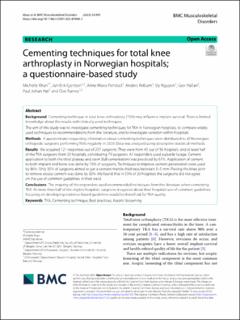| dc.contributor.author | Khan, Michelle | |
| dc.contributor.author | Gjertsen, Jan-Erik | |
| dc.contributor.author | Fenstad, Anne Marie | |
| dc.contributor.author | Refsum, Anders Myhre | |
| dc.contributor.author | Nguyen, Uy Viet | |
| dc.contributor.author | Hallan, Geir | |
| dc.contributor.author | Høl, Paul Johan | |
| dc.contributor.author | Furnes, Ove Nord | |
| dc.date.accessioned | 2024-04-19T12:57:34Z | |
| dc.date.available | 2024-04-19T12:57:34Z | |
| dc.date.created | 2023-11-20T21:40:28Z | |
| dc.date.issued | 2023-11-18 | |
| dc.identifier.issn | 1471-2474 | |
| dc.identifier.uri | https://hdl.handle.net/11250/3127460 | |
| dc.description.abstract | Background: Cementing technique in total knee arthroplasty (TKA) may influence implant survival. There is limited knowledge about the results with clinically used techniques.
The aim of this study was to investigate cementing techniques for TKA in Norwegian hospitals, to compare widely used techniques to recommendations from the literature, and to investigate variation within hospitals.
Methods: A questionnaire requesting information about cementing techniques were distributed to all Norwegian orthopedic surgeons performing TKAs regularly in 2020. Data was analyzed using descriptive statistical methods.
Results: We acquired 121 responses out of 257 surgeons. They were from 45 out of 56 hospitals, and at least half of the TKA surgeons from 20 hospitals, constituting 79 surgeons. All responders used pulsatile lavage. Cement application to both the tibial plateau and stem (full cementation) was practiced by 61%. Application of cement to both implant and bone was done by 70% of surgeons. Techniques to improve cement penetration were used by 86%. Only 35% of surgeons aimed to get a cement mantle thickness between 3–5 mm. Flexing the knee joint to remove excess cement was done by 82%. We found that in 55% of 20 hospitals the surgeons did not agree on the use of common guidelines in their ward.
Conclusions: The majority of the responders used recommended techniques from the literature when cementing TKA. At more than half of the eligible hospitals, surgeons disagreed about their hospitals’ use of common guidelines. Focusing on developing evidence-based guidelines would be beneficial for TKA-quality. | en_US |
| dc.language.iso | eng | en_US |
| dc.publisher | BMC | en_US |
| dc.rights | Navngivelse 4.0 Internasjonal | * |
| dc.rights.uri | http://creativecommons.org/licenses/by/4.0/deed.no | * |
| dc.title | Cementing techniques for total knee arthroplasty in Norwegian hospitals; a questionnaire-based study | en_US |
| dc.type | Journal article | en_US |
| dc.type | Peer reviewed | en_US |
| dc.description.version | publishedVersion | en_US |
| dc.rights.holder | Copyright 2023 the authors | en_US |
| dc.source.articlenumber | 900 | en_US |
| cristin.ispublished | true | |
| cristin.fulltext | original | |
| cristin.qualitycode | 1 | |
| dc.identifier.doi | 10.1186/s12891-023-07040-2 | |
| dc.identifier.cristin | 2199146 | |
| dc.source.journal | BMC Musculoskeletal Disorders | en_US |
| dc.identifier.citation | BMC Musculoskeletal Disorders. 2023, 24, 900. | en_US |
| dc.source.volume | 24 | en_US |

